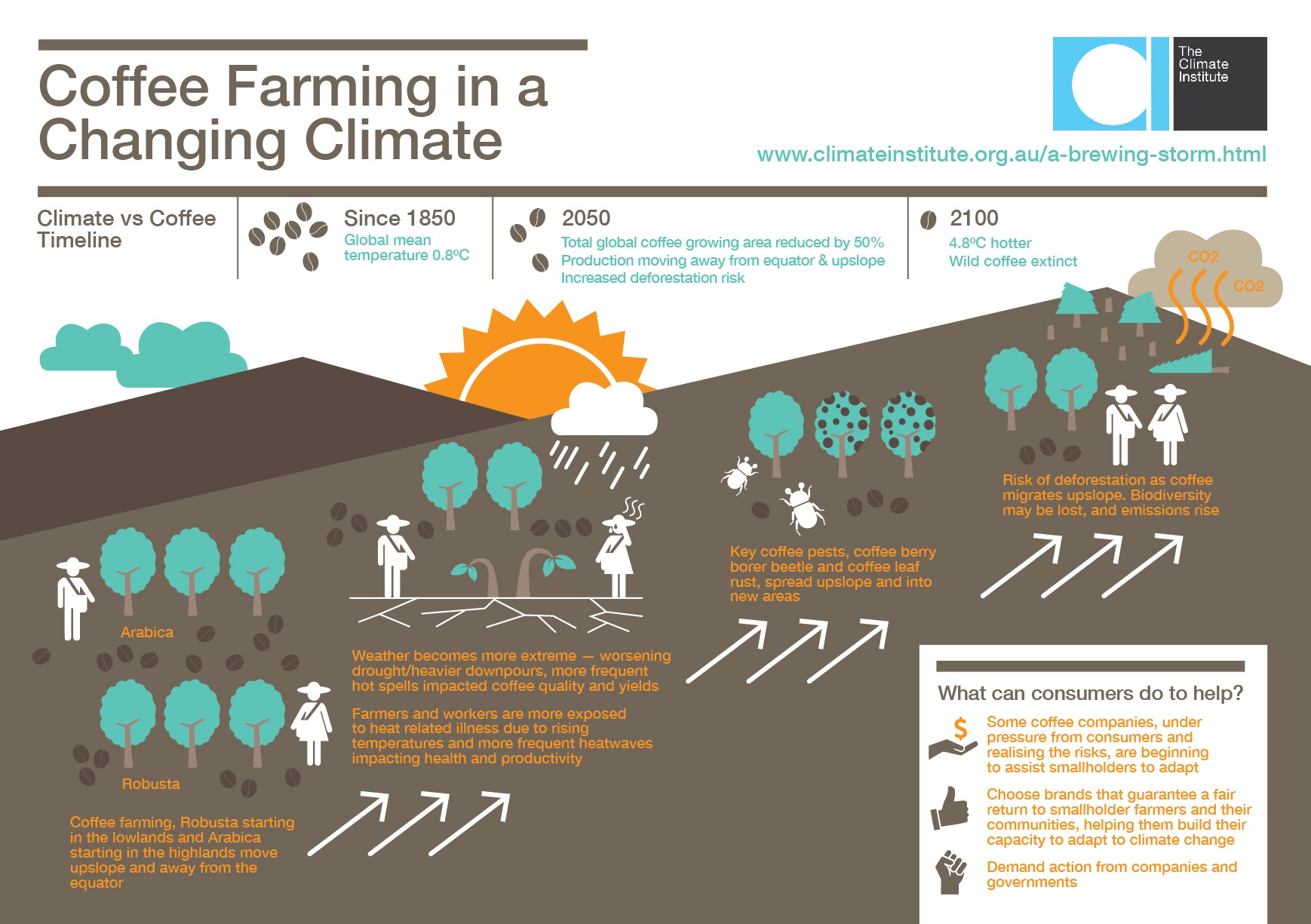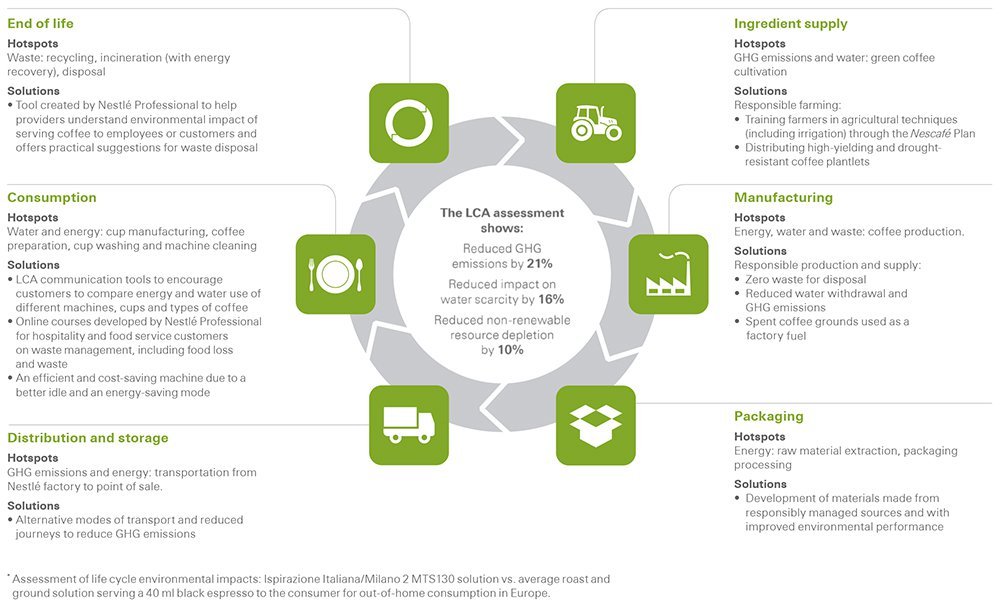Enjoy that cup of coffee, it may be your last…

Can Nestle save the coffee industry from climate change?
The Effects of Climate Change in the Coffee Business
According to a recent report by World Coffee Research, global coffee demand will double by 2050, while suitable production area will decline by 50%[1]. Rapid increases in temperature and decreases in rainfall have had permanent negative effects on farmland, forcing coffee farmers upslope to avoid the effects of extreme weather changes and resulting in lower quality harvests.
Temperature also directly affects coffee’s flavor. Beans ripen more slowly in cooler temperatures, leading to more complex flavor elements. In higher temperatures, coffee ripens too quickly, reducing its flavor profile. Major players in the coffee industry such as Nestle, Mondelez International and Kraft foods must find ways to improve coffee quality and yield in order to ensure the industry’s sustainability. Nestle plays a particularly critical role: as the world’s largest food and beverage company, it has a central role in developing environmentally sustainable innovations.
 Exhibit 1: Effects of Climate change on coffee farms.[2]
Exhibit 1: Effects of Climate change on coffee farms.[2]
Nestle’s Response to Climate Change
Nestle has established a long-term goal to strive for zero environmental impact in its operations by 2030.[3] In order to achieve zero impact, the company has short-term goals for reducing greenhouse gas emissions which it hopes to achieve by 2020. [3] It uses a framework called Life-cycle assessment (LCA) to assess and minimize the impact of global warming on the various stages of their supply chain.
The Company has been making strides towards achieving its sustainability goals. As of 2016, Nestle has reduced greenhouse gas emissions by 39% per tonne of product since 2006. [4] Additionally, Nestle was one of only 114 companies recognized by the CDP (formerly the Carbon Disclosure Project) as one of the world’s leading businesses on environmental performance in 2017.[5]
Raw Materials – In 2010, Nestle implemented “The Nescafe Plan” in 13 of its major coffee-producing areas. The initiative helps train local farmers in sustainable farming practices. Nestle also invests in research and development in plant science to help find ways to help farmers improve the quality and yield of their coffee trees.
Manufacturing – The company mandates all its operations to optimize electricity consumption and identify opportunities for purchasing renewable energy from the local power market.
Transport and distribution – In 2011, the Company stopped using road, and started using rail and sea shipping in order to reduce its emission of carbon dioxide (CO2).
Exhibit 2: Nestle’s Life Cycle Assessment[6]
What more can Nestle do?
Nestle has made a lot of strides in reducing the environmental impact of its operations. However, going forward, the company needs to increase focus on the first and most important stage of its supply chain – production. The future of the entire coffee industry is at stake and focusing primarily on reducing Nestle’s gas emissions, while a worthwhile venture, will not be enough to save it. Nestle must invest more in research and development, to help improve the quality of coffee bean production. There are opportunities to partner with other food and beverage companies, or with organizations such as World Coffee Research which conducts research to develop new genetic varieties of coffee that will be more resilient to extreme temperatures. [7]
The company may also need to consider opportunities to help coffee farmers earn more revenue on their harvests. New competitors entering the market are willing to pay farmers more, and Nestle may lose some suppliers to companies such as Thrive which essentially eliminates the middle man in the supply chain (distributors, wholesalers and retailers) by buying directly from the farmers and selling directly to consumers.[8]
Other Considerations
According to estimates from Rabobank international, 2017 is gearing up to be the fourth consecutive year of coffee deficit[9]. The price of green coffee continues to stay relatively low despite increasing costs to produce and depleting supply. Can Nestle afford these increasing costs to make coffee available to consumers? Will Nestle be forced to increase the price of their coffee, and how will that affect demand?
Many coffee farmers have begun diversifying their farmland to ensure that they can make stable income to offset the loss of income due to decreased yield as a result of global warming[10]. How will that affect already dwindling supply and what role can Nestle play in mitigating this?
Sources
[1] World Coffee Research “The Future of Coffee – Annual Report” 2016 https://worldcoffeeresearch.org/media/documents/2016_Annual_Report.pdf, accessed November 2017
[2] The Climate Institute “ A Brewing Storm: the Climate Change Risks to Coffee” http://www.climateinstitute.org.au/verve/_resources/TCI_A_Brewing_Storm_FINAL_WEB270916.pdf, accessed November 2017
[3] Nestle http://www.nestle.com/csv/planet, accessed November 2017
[4] Nestle http://www.nestle.com/csv/planet/climate-change, accessed November 2017
[5] CDP “The A List” https://www.cdp.net/en/scores-2017, accessed November 2017
[6] Nestle “Product Life Cycle” http://www.nestle.com/csv/planet/product-life-cycle
[7] World Coffee Research “Breeding for the future” https://worldcoffeeresearch.org/work/breeding-future/, accessed November 2017
[8] Www.wired.com “The next big thing you missed: Saving the coffee industry by running it like silicon valley” https://www.wired.com/2014/07/the-next-big-thing-you-missed-saving-the-worlds-coffee-supply-by-acting-like-a-tech-company/ , accessed November 2017
[9] Bloomberg “The Scientists Fighting to Save Us From a World Without Coffee” https://www.bloomberg.com/news/articles/2017-04-28/the-scientists-fighting-to-save-us-from-a-world-without-coffee, accessed November 2017
[10] Perfect Daily Grind “Diversification in Specialty Coffee Farming: The Agricultural & Economic Case” https://www.perfectdailygrind.com/2016/02/diversification-in-speciality-coffee-farming-the-agricultural-economic-case/, accessed November 2017




First reaction – this is terrifying. What are we to do without coffee?!
Given that we are now in the 3rd wave of coffee (1st being at home Maxwell house; 2nd being the Starbucks to mass market, 3rd being the niche players – Gregory coffee; Philz coffee etc), there is a definitive market with a higher willingness to pay for quality. While personally, I’d be perfectly happy with my over-roasted Starbucks, others may not be – therefore, would market dynamics resolve this in the future? Asked another way, in the future when coffee becomes a high-priced luxury for the masses, would that spur additional innovation to cultivate the crop (a la Malthus / Malthusian thinking)?
I believe the play for Nestle wouldn’t be so much internal commitments to sustainability (as the environment effects us all), but rather, in working with farmers to develop practices that would allow them to maintain a healthy crop yield going forward in an environment of rising temperatures.
I’m really interested in the aspect of this paper that relates to helping farmers increase their revenue before losing these farmers to competitors. I wonder if there’s a way to secure these farmer relationships and get them onboard with the importance of sustainability. Perhaps there’s a way to show how if they continue working with Nestle, not only will they benefit from a revenue perspective but also from a sustainability perspective. Are there additional incentives for these farmers to keep working with Nestle?
I think you hit the nail on the head when mentioning that, although a noble mission, Nestle’s reduction of emissions and use of renewable energy is not enough to save the industry. The coffee industry has a ton of players and has a massive global market. The key for Nestle is definitely in their R&D efforts to create more sustainable farming practices or even new coffee harvesting techniques altogether. I am curious to learn more about what kind of R&D breakthroughs there have been in the past and to find out what Nestle is currently working on.
As a concerned consumer I was intrigued by Exhibit 1 where it shows the three things consumers can do to help – most of which point to demanding more out of coffee brands to promote sustainable practices and support smallholder farmers. Have any initiatives like these already happened? I don’t believe the average consumer today understands the risks facing the coffee industry and it will be interesting to see how they react (because I know coffee drinkers need their coffee) when they learn about the threats ahead.
Interesting and worrisome topic! This paper reminded me a lot of the IKEA case. In the section, “What More can Nestle Do,” I completely agree that Nestle needs to invest in R&D projects to increase coffee bean yields. Similar to IKEA, I would pose the question if Nestle should try R&D projects to recycle coffee beans. I think the final piece of the IKEA case that relates to this paper is the question of whether Nestle should consider vertical integration, buying coffee farms not only to implement sustainability initiatives but also to test new R&D projects.
Very interesting article! While I applaud Nestle for being proactive about climate change rather than reactive, I agree that they need to focus more on production in order to achieve their sustainability goals. Specifically, there is an opportunity to partner with large coffee farmers to find ways to increase the revenue on their harvests. Perhaps there is a way to do it without paying farmers more, but instead by partnering with and investing in their businesses to improve their efficiency and overall yields, thereby lowering the farmers’ costs and increasing their profits without requiring more land.
Without coffee, this comment would not have been typed, so this topic is near and dear.
I completely agree with your assessment that Nestle should focus on production: improving yields and reducing waste. While helping their suppliers improve sustainability and yields is noble and likely effective, Nestle must also put its money where its mouth is and demonstrate to its suppliers that it is similarly investing in sustainability and yield improvement.
Longer-term, perhaps Nestle could look to consumer education and new product development. The coffee industry experienced its second year of supply deficit in 2015/2016 [1]. Therefore, coffee drinkers must be educated to reduce usage waste. Every drop counts. Additionally, Nestle could explore new products that require fewer beans for an equally strong coffee. Nestle would never want to sell less coffee or lessen demand, but they could reduce the raw materials necessary to make each beverage.
[1] International Coffee Organization, October 2016. http://www.ico.org/monthly_coffee_trade_stats.asp. Accessed November 2017.
This article reminds me a lot of my previous employer-Mars Inc. who is also tacking with the pressing issue of the shortage of quality cocoa. If there will be a day we can never have a cup of coffee, we may not see any chocolate as well.
I definitely agree that the effort of Nestle is not sufficient given the complex reason and stakeholders’ interest. It needs to leverage the collective resource of industry players, government, and NGOs. All the coffee players are in the same boat. If the supply of coffee is not sustainable, everyone will suffer. One thing Mars did well is to share its research result, coming out from a tremendous financial and human resource investment, on Cocoa genes to the world in the hope of stimulating more attention and effort on studying how to maintain and grow the cocoa productivity. It can be a good reference in terms of how to solving the seemingly unsolvable problem by advocating and cooperating with many others, even competitors.
http://www.mars.com/global/sustainable-in-a-generation/our-approach-to-sustainability/raw-materials/cocoa